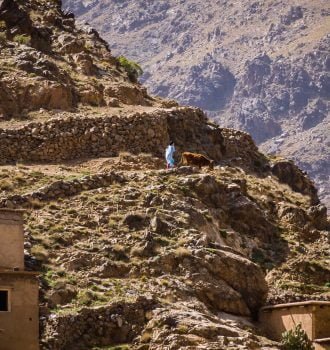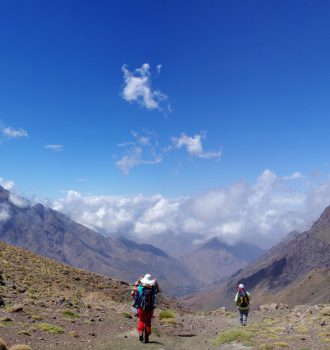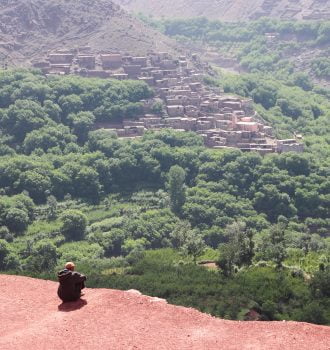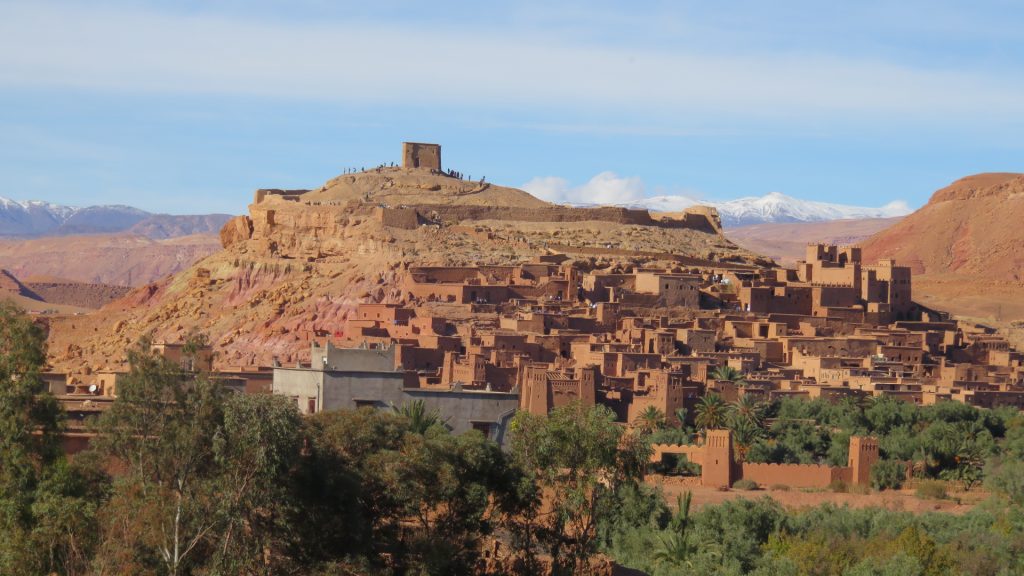Toubkal Valley Trekking
Upper valleys of Toubkal
Trekking: Toubkal or Tubkal is a mountain peak in southwestern Morocco, located in the Toubkal ... The route starts some distance down the valley from the Toubkal refuge, ...
Atlas Mountains Hikes
The Best Trails for Hiking in the Atlas Mountains in Morocco ; 1. Mount Toubkal. TOP CHOICE FOR ICONIC SUMMITS. Easy access to the mountain from to Marrakech.
3 Day trek Berber villages
An easy & interesting overnight trek in a colorful and authentic Azzaden valley at the heart of the Berber Ait Ouazzaden tribe.
UPPER VALLEYS OF TOUBKAL
TREKKING & HIKING
The Toubkal Berber Villages are situated 75 km to the south of the lively city of Marrakech. The Toubkal massif features a mountainous landscape, with its highest peak in North Africa towering at 4,167 meters. In this area, you can find terraced fields grown at impressive heights, steep valleys, and stone villages that demonstrate the resilience of the locals against a tough climate. This seven-day trek in the Toubkal region allows you to discover the Berber villages as you climb, without any technical challenges. Mount Toubkal stands as the highest point in North Africa.
During our Toubkal Berber villages hike, we will follow the ancient paths that the locals from these remote villages use every day on foot. It’s a chance to meet the Berbers of the mountains and discover their warm hospitality, unique way of life, and fascinating traditions. You’ll be amazed by their kindness and learn to appreciate their customs. And don’t worry, we’ll still be immersed in the special mountain atmosphere that makes this Toubkal hike so extraordinary.
Trekking: NB: walking times and elevations are given as an indication.
- — Throughout the days of walking, the guide introduces you to traditional life, still very present in these valleys: work in the fields, livestock, housework, architecture, use of natural space, customs, contrasts and adaptation to the modern world…
7 Days Berber villages trek - Toubkal Atlas Trekking
- Authentic and Welcoming Approach: Step into the Berber culture with a genuine and friendly encounter, embracing the beauty of nature and the warm hospitality of the Imazighen people.
- Scenic Beauty: Witness the stunning landscapes adorned with charming villages nestled among towering mountains and high peaks.
- EComfortable Lodging: Experience the coziness of each night spent in double rooms, available in inns or ryads, offering a unique chance to stay in Berber villages.
- Easy Transfers: Enjoy quick and stress-free transfers, allowing you to make the most of your time exploring the beauty of the Berber countryside.
- Small Group Experience: Join us on this adventure with a cozy group of no more than twelve people, guaranteeing a special and tight-knit atmosphere.
- Cultural Discovery: Explore the daily life and ancient traditions of the Berbers as you venture into the foothills of the majestic Toubkal.
- Deep Dive into Heritage: Immerse yourself in the rich heritage of the Imazighen, marked by a strong connection to the land, sacred customs, and unwavering hospitality, all essential to Morocco’s identity.
- Trekking Experience: Immerse yourself in a region or country with a thorough exploration approach, blending accessible paths and captivating landscapes.
- Level of Difficulty: Trek for 4 to 5 hours daily on clearly marked trails, paths, or undulating terrain.
- Enhanced Comfort: Indulge in comfort and services exceeding standard travel expectations.
- Semi-Itinerant Circuit: – Explore the region through a semi-itinerant route. – Spend 2 to 3 nights at various accommodations, including hotels, riads, inns, and guesthouses.
- Duration: – Set aside 7 days for this rewarding adventure.
- Portage: – Carry only your essential items for ease of mobility.
- Accommodation: – Enjoy a variety of lodging choices, from hotels to traditional ryads, inns, and guesthouses.
- Expert Guidance: – Take advantage of the expertise of an Atlas Trek Guide fluent in local languages and English.
- Group: From 4 to 12 participants
DAY 1: HOME - MARRAKECH:
Flight to Marrakesh. Installation in a four-star hotel near the city center. Depending on the arrival time of the flight, free discovery of Marrakech. The Djemaa el-Fna square, listed as a world heritage of orality by Unesco, is the meeting place for snake tamers, “watchers” of the world, dazzled backpackers, peasants descended from the Atlas. amazed by this world so different for them, and traders who pile dates, figs and grains of sunshine on their caravans in strange mountains. Free evening.
- Accommodation: hotel.
- Free meal.


DAY 2: MARRAKECH - OURIKA - SETTI FATMA - THE SEVEN WATERFALLS:
Transfer by minibus to the Ourika Valley. Installation is at the accommodation. At noon, it’s the perfect opportunity to enjoy one of the restaurants by the river and taste the famous local Berber tajine, accompanied by salad and mint tea. The Ourika Valley is the favorite destination of Marrakchis for a day trip; they come here to relax and enjoy the tajine, especially on weekends, and even more so in summer when they go upstairs to cool off. A short transfer by minibus to the top of the valley, Setti Fatma Walk to discover the waterfalls that make the place famous.
- Positive elevation gain: 200 m.
- Negative drop: 200 m. 2 to 3 hours of walking
- Accommodation: guest house.
- Meals included: morning, noon, and evening.
- Transfer: 1h30.
DAY 3: OURIKA - OUKAIMEDEM (2600 M) - TIZI N'AIDI (2980 M) - TACHEDIRT (2300 M):
The minibus takes us to Oukaimeden (the only ski resort in the Atlas, at an altitude of 2,600 m). Discovery of the rock engravings on the plateau Lunch in one of the restaurants in the village; here again, the Berber tagine is a must! After the passage at the foot of the Ouka chairlift (as the insiders say), climb in laces to the tizi n’Aït Aidi; from the pass, enjoy a beautiful view of the villages of Imlil (Aït Mizane). The slopes of Toubkal appear, surrounded by 4,000-meter peaks. Descent by a good winding path to Tachedirt, where we settle down for the night.
- Positive altitude difference: 380 m.
- Negative drop: 680 m. 4 to 5-hour walk
- Accommodation: hostel.
- Meals included: morning, noon, and evening.
- Transfer: 1h30.


Day 4: TACHEDIRT - TIZI N'TAMATERT (2279 M) - IMLIL (1800 M):
Today’s hike is an opportunity to immerse ourselves in the agricultural traditions of the Berber mountain people. The irrigated terraces go up very high on the sides of the valley. The upper channel (targa) forms an almost rectilinear boundary between the brown of the mountains and the green of the crops; the villages are built above so as not to lose any arpent of fertile land.
Descent to the villages of Tamguiste, Ouaneskra, and Tinghrine. Crossing the wadi to attack the climb to Tizi n’Tamatert. If you are in good shape, the ascent to Aourir n’Ouassif (2,724 m, 400 m of additional vertical drop, positive and negative) comes to complete this day pleasantly, bringing a magnificent view overlooking several valleys and many villages. clinging to the mountainside. Crossing a forest of Aleppo pines to reach the ryad above Imlil, where we stay for two nights.
- Positive altitude difference: 400 m.
- Negative drop: 850 m. 4 to 5-hour walk
- Accommodation: ryad.
- Meals included: morning, noon, and evening.
DAY 5: IMLIL - TIZI M'ZIK - Tamsoult (2490 M)
Begin your day with a delightful breakfast on the terrace, overlooking the majestic Toubkal mountains. Then, set off for a full day of hiking. As you traverse numerous villages, a well-defined trail will lead you to the Tizi M’Zik pass, situated at an impressive altitude of approximately 2,460 meters. From this vantage point, you’ll be treated to breathtaking views of the Imlil valley and the Azzaden valley. The stark contrast between the lush green valleys and the arid mountains that tower over them is truly awe-inspiring.
Lunch will be enjoyed at the pass or in its vicinity, with a mule carrying all the necessary provisions for a delightful picnic. Our skilled cook will take care of every detail, ensuring that this Berber lunch becomes an unforgettable experience.
After lunch, we will continue our hike to reach the breathtaking Igholidin waterfall, which showcases one of the most stunning landscapes in the area. The sight of the cascading waters amidst the mountainous backdrop is truly mesmerizing. Following this awe-inspiring experience, we will return to spend the night at the Tamsoult refuge, surrounded by the serene beauty of the mountains.
- Ascent: 900 m.
- Negative drop: 200 m. 5 to 6-hour walk
- Accommodation: Refuge.
- Meals included: morning, noon, and evening.


DAY 6: REFUGE OF TAMSOULT- AZZADEN VALLEY- IMLIL :
Begin your day with a delightful breakfast, and then set out on a scenic hike through the Berber villages in the Azzaden valley. These villages are renowned for their vibrant mountains, which add a burst of color to the landscape. We will enjoy a well-deserved lunch at Tizi Ouadid, situated at an altitude of 2225 meters. Afterward, we will continue our walk towards the village of Arghane. Finally, we will conclude our adventurous journey by spending our last night in the picturesque Imlil valley, where accommodation will be provided at a charming riad.
- Accommodation: Riad.
- Meals included: morning, noon, and evening
- Ascent : 450m
- Descent: 400m
- walk: 4h to 5h.
DAY 7 : IMLIL- MARRAKECH
After a last breakfast in the mountains, we transfer to Marrakech, where we arrive at the end of the morning. Installation in a four-star hotel. Free stroll on the Djemaa el-Fna square, in the souks and the medina… Why not the Menara gardens, the tombs of the Saadians, the Majorelle gardens, or even Guéliz, modern Marrakech? In the evening, however, it is the place to be, where the heart of Marrakech beats.
- Accommodation: Hotel
- Meals included: morning
- Free Meals: noon-evening
- Transfer: 1h30m
Berber Villages

Morocco Berber History
Believe it or not, Berber history goes back to prehistoric times. In fact, Morocco is home to the oldest Homo Sapiens ever found — nearly 300,000 years old! This means that the indigenous people of Morocco have been here for a long, long time. Longer than any other known group of people in the world.
Much of what we know about the very first people of Morocco come from archeological records. Of the Berbers themselves, well, much of that history is oral. In fact, it’s probably a mistake to call them “Berber” at all!
The Berbers proudly call themselves the Amazigh, the “free people.” The name “Berber” derives from “Barbary,” that is, from the Greek barbaria. Though “Berber” is commonly used throughout Morocco, both by those who identify as Amazigh, and other Moroccans, it’s probably not the nicest or most accurate name.
Thousands of years ago, the Amazigh ruled all of North Africa, largely through different tribes. They would crisscross over the Sahara and throughout the southern basin of the Mediterranean for trade and travel. Over the centuries, they have been called by many names:
The ancient Greeks called them “Libyans”; Romans called them variously “Numbians,” and “Africans” while much of medieval Europe referred to this collection of tribes in North Africa as “Moors.” In fact, it was the Arabs who came up with the Berber name: Al-Barbar. This was likely a re-adaptation of the ancient Greek term of “barbar.” However, there is some thought, as written by the Arab scholar Ibn Khaldun, that there could have been an ancient person by the name of “Barbar,” in some texts, a mother named “Barbara,” who gave the name to the tribes, perhaps around Somalia.
When Moulay Idriss, the founder of modern Morocco, fled the Abassid Dynasty, he brought Islam with him, peacefully converting the Awraba tribe and establishing the Idrissid Dynasty. Prior to then, most Berbers across all of North Africa were Anamist, Christian or Jewish. Islam quickly spread through the region, though somewhat different than what was practiced in Middle East. Two of the greatest historic Moroccan dynasties, the Almoravids and Almohads, were Islamic Berber dynasties that ruled large parts of Spain and northwest Africa.
Over the years, the Amazigh have battled, traded, negotiated, and played host to the Phoenicians, Carthaginians, Romans, Arabs, Spanish, and French. Even though the Romans and others have tried to colonize the Berber people, they have managed to preserve their own language and culture and in reality have never been conquered!
Berber language is primarily oral in nature, although they have had their own writing system for at least 2,500 years. Sometimes hard to find, the earliest writings can be found catalogued in the small museums throughout the south. More recently, the language has been officially codified and, alongside classical Arabic, is one of the two official languages of Morocco.


